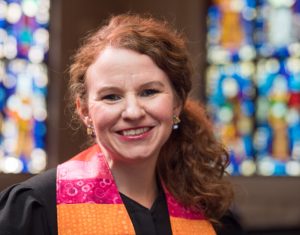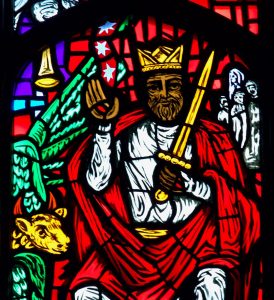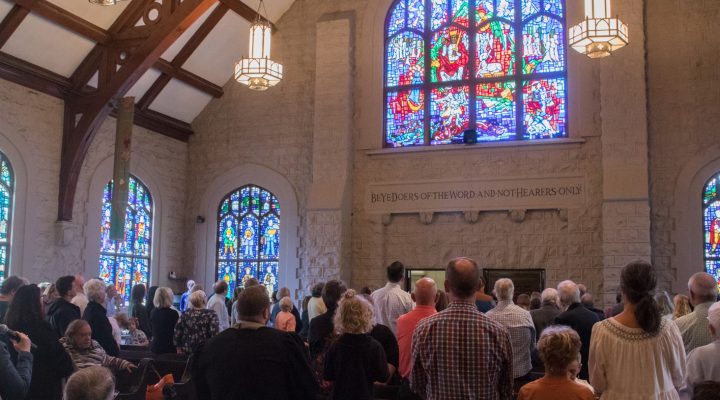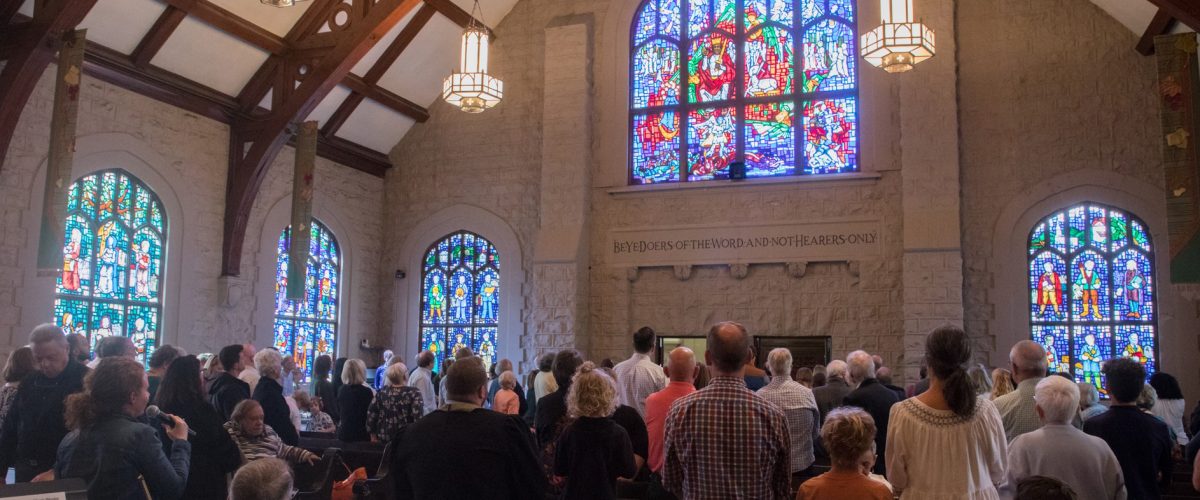Highland Baptist Church in Louisville transformed its stained-glass Jesus from white to brown to accurately reflect his ethnicity, to continue the congregation’s ongoing reparations work and to push back against Christian nationalism.
“We wanted to correct the misrepresentation of Christ in our Revelation window,” said Lauren Jones Mayfield, associate pastor for care and justice at the Cooperative Baptist Fellowship partner congregation. “Palestinian Jews are not white Americans in their appearance, and we know what we filter into our minds through symbols, imagery and iconography can become representative of what we worship.”

Lauren Jones Mayfield
The racially transformed Jesus also negates “a Christian nationalist vibe that is hijacking American Christianity for the worse,” she said. “In our worship and in our Christology, we need to do our best to reflect what we know to be true.”
The stained-glass retinting, which occurred Oct. 10, emerged from Highland’s years-long and multifaceted reparations effort. Its facets include liturgical expressions of confession and repentance for racism and white privilege, anti-racism advocacy work and financial contributions to grassroots community organizations, said Nancy Goodhue, the lay leader who chairs the church’s Reparations Task Force.
That group’s research found the church generally remained quiet about racial disparities that have divided the city and continue to plague the community. The congregation also has enjoyed white privilege and the social and financial benefits that come with it, she said.
“We are reaping a lot of benefits that Black people have not enjoyed, so we are considering holding a service of repentance. And we are addressing that now by confessing racism in our worship services.”
Confronting the imagery throughout the facility has been another component of the reparations process, she added. “That has to do with our windows and other images in the church, including enslavers in our stained-glass windows and one in our Fellowship Hall.”
While the church’s 1893 founding post-dated slavery, some of the 1970s-era windows include images extolling prominent Baptist slave holders and slavery advocates. The congregation had grown uneasy about those panels and in 2021 hosted a visit by Black advisers on the reparations process and on how to handle the enslaver depictions.
“We were asking ourselves how to deal with those images,” Jones Mayfield said. “Should we hang black cloth over them or deconsecrate them? Or should we just put up a plaque” calling attention and repenting for the representations?
While the advisers gave differing answers about those panes, they were struck by the white stained-glass Jesus in the Gothic sanctuary and unanimously agreed something had to be done about it.
“One of them used the term ‘idolatry’” to describe the window, Goodhue said.

Mary Alice Birdwhistell
That encounter kicked off an internal discussion about how the potential expense of replacing the window would draw funds from financial reparations, Highland Pastor Mary Alice Birdwhistell said. “But where we landed is that it’s not an ‘either-or’ because the imagery is important in what it communicates theologically.”
However, the financial impact was significantly lessened by having Jesus retinted rather than replaced.
Jones Mayfield said her first experience of seeing the altered Christ figure was moving. “To see a brown Jesus, it was just overwhelming. The way the light is reflected through the glass and all the intricacies are preserved, it is incredibly powerful.”
But some young people in the congregation were concerned the church might let pride in the modified window overshadow the church’s dedication to reparations work, Jones Mayfield said. “We responded that this is not our first step, nor is it our last step. In some ways this is a tangible step, but it is also symbolic of what really matters in reparations: confession, advocacy and dollars.”
A Facebook user expressed a similar concern in a comment to Highland’s announcement about the brown Christ figure: “As long as they are helping people of color who need help with bills, food, shelter etc. …”
“It’s a next right step in the direction we felt led to be going, and we realize there are many, many more steps to take.”
Birdwhistell replied that the congregation had considered that very point: “Before this change in our windows, our first step was to create a Reparations Fund and to commit to give a portion of our budget to pay reparations in our community every year. We have an advisory board of people of color from here in Louisville helping us to make decisions about where/how these funds can best be used to help with exactly the kind of needs that you name above, specifically focusing on home ownership and education.”
Separately, Birdwhistell said the historically and theologically accurate stained-glass Christ actually confirms the reparations path the church is walking.
“I love looking up and seeing it. It’s just five little pieces (of glass) — a face, two hands and feet. It’s a next right step in the direction we felt led to be going, and we realize there are many, many more steps to take.”

Newly retinted Christ window at Highland Baptist Church in Louisville, Ky.
Another big step was taken last year when the congregation voted to annually donate 1% of the church budget to local organizations that address wealth gap issues in Black communities, including through employment and housing work, Goodhue said.
Highland also seeks to join or help develop coalitions of other organizations intent on making financial reparations a national cause, she said. “We are hoping to find other people like us who want to do this work and to see a different kind of nation.”
The ministry of reparations is a long-term one, Birdwhistell reiterated. “It would be beautiful to find other congregations willing to wrestle with this and journey with us, but we are mindful that change takes time, particularly in congregations.”
She urged other congregations to take whatever small steps they can in the movement for racial justice and reparations. “Just ask what is the next step you could take in your context, because a few years ago we didn’t think we could take this step, either.”
Related articles:
Knowing a church’s history on slavery can be a nudge toward redemption, historians say
What to do if you unearth a history of slavery in your church, college or institution?


